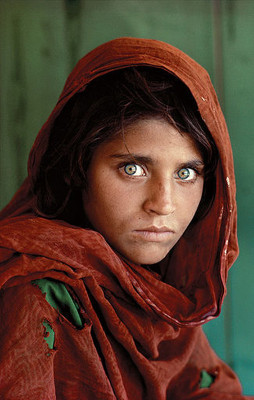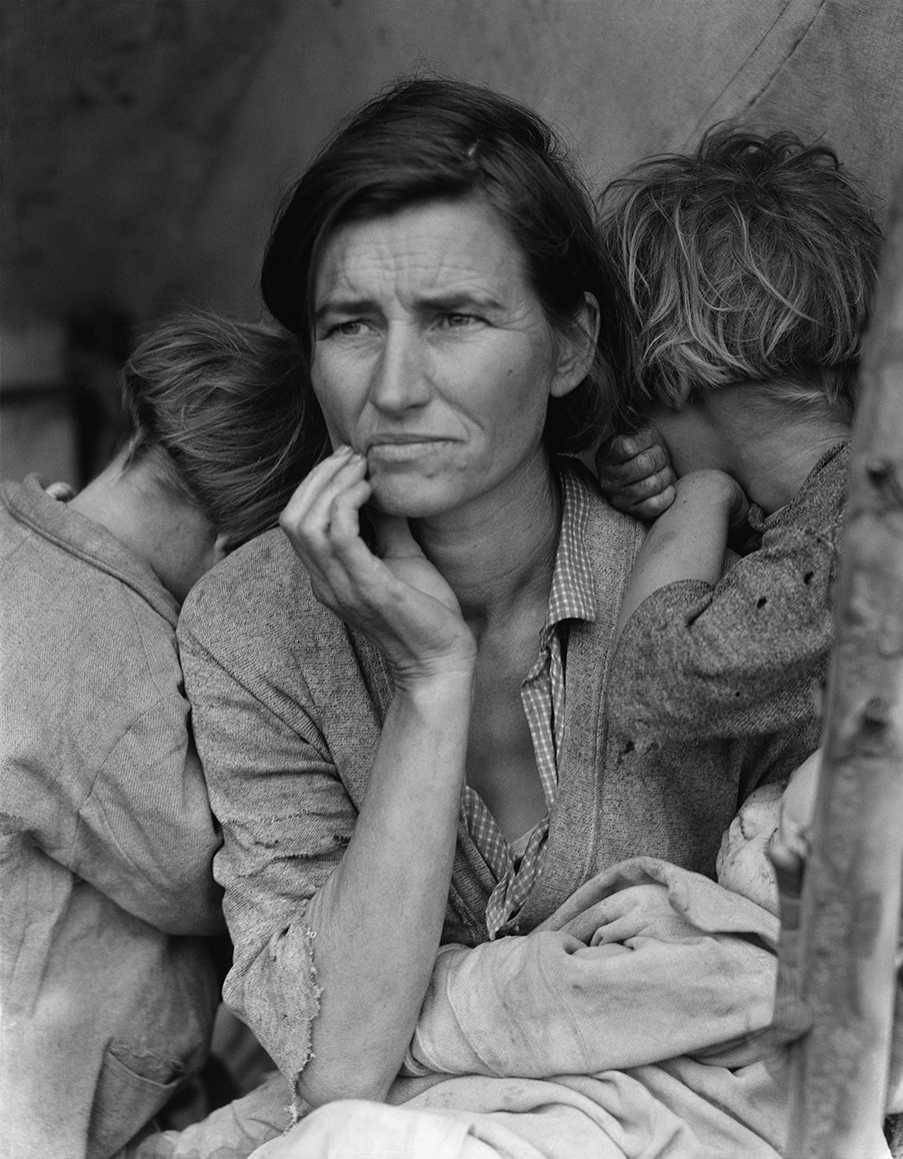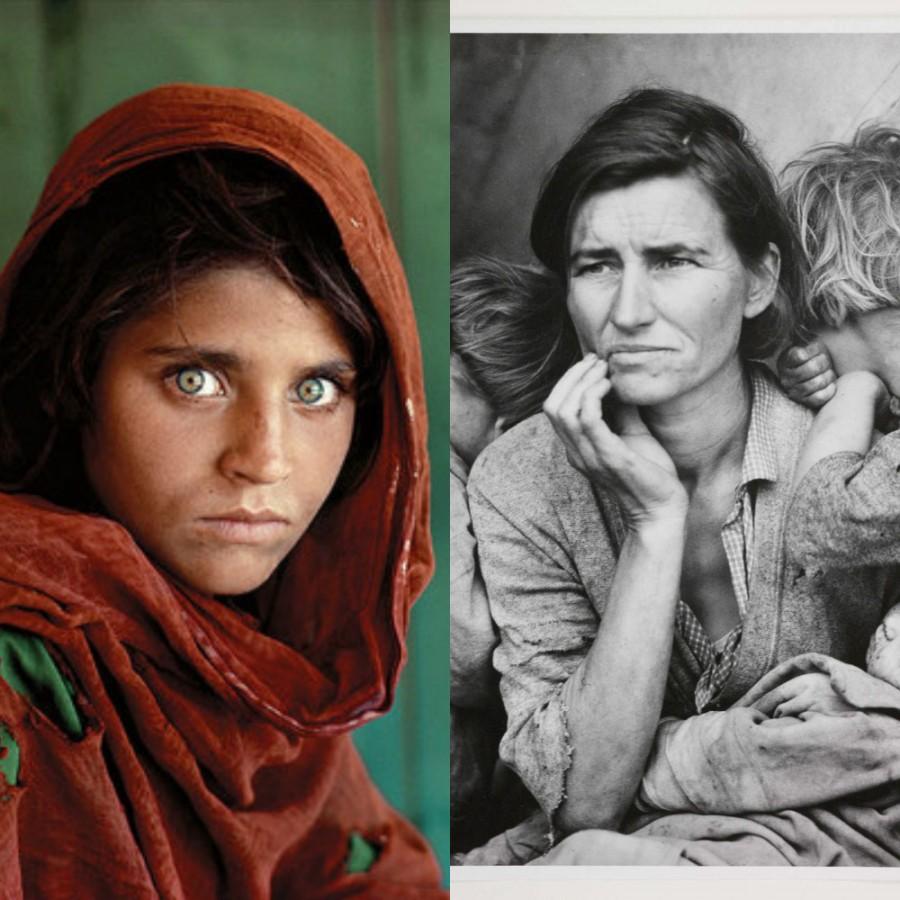History in photos: “Afghan Girl” (1984), “Migrant Mother” (1936)
Steve McCurry (left) and Dorothea Lange
Sharbat Gula (left) and Florence Owens Thompson in their iconic photos.
January 5, 2016

“Afghan Girl” by Steve McCurry. Image from Wikipedia, creative commons. Originally by National Geographic.
In June of 1985, a girl’s eyes pierced the world. On the cover of National Geographic, a girl with striking, bright green eyes. She was 12 years old but looked like she had seen lifetimes. People who saw the magazine were forced to stare into her eyes and see her experiences and feel her scorn.
In 1936, on the front of the San Francisco Times, a woman was pictured. A slender 32 year old mother with an infant in her lap and two of her other children burying their faces in her shoulders. The look on her lined face shows multiple things: Desperation, fear, sadness, resignation.

Available from the United States Library of Congress’s Prints and Photographs division
One thing that these two pictures and these two women have in common is that it was a long time before the world knew who they truly were. In the titles of the photos they are simply identified by what they were seen as: A girl and a mother.
However, they were leagues above those simple labels. Both had lived through some of the harshest parts of their country’s history. The girl lived during the Soviet occupation of Afghanistan, was made an orphan, and had to leave the country along with her siblings and grandmother. The mother had 10 children to feed and care for throughout her life, living in intense poverty until her marriage to a hospital administrator.
The girl is Sharbat Gula. The mother was Florence Owens Thompson. Although both women are very different, their photographs are very similar when you look at them side by side. They are both shown in a moment of vulnerability, and both are portraits. Their photographs inspired others to take action towards helping their situation. They lived decades apart from one another, and yet their struggles were ubiquitous.
Even though the photos are singular in their own ways, the one that is the more affecting for me is the Afghan Girl. As mentioned before. Sharbat Gula was only 12 when the picture was taken, and yet she looks a little older, maybe her late teens. Then there’s those eyes. Those sea green, lovely and almost devastating eyes. They are perhaps the most striking part of the picture, brought out in part by the red scarf draped over her head. One thing I learned when researching Gula and the photo is that in her Pashtun culture, women are not to look into the eyes of strangers or men other than their husbands. So for this young girl to stare unafraid into the camera is something that has always stuck with me about the photo.
In 2002, Steve McCurry, the photographer of the Afghan Girl, went on a search in order to find out what had happened to her. He didn’t have much to go on, as due to the girl’s tradition, McCurry did not learn her name. After much searching and many women wrongly stepping forward as the girl, a 28-30 year old Sharbat Gula was found living in Pakistan, along with a husband and three daughters (a fourth died in infancy). When researching an older Gula, one can see that she is drastically changed, ravaged by time and hardship. Her eyes are the same but have more of a sadness in them than the determination she showed in the original picture. Personally it makes me sad to know that Gula could not find a much better life than the one she was given. Although you can get a sense that she is somewhat resolved with her life in the picture from 2002, where she holds her infant daughter. Nowadays, Gula goes back and forth with her family between Pakistan and Afghanistan, depending on the situation.
All that is not to say that the picture of Florence Owens Thompson is without it’s own merit. The picture of the Migrant Mother has a sense of melancholy that the Afghan Girl doesn’t, which is helped by the black and white that the photo was taken in. The main photo, along with the other five of Thompson’s family that Dorothea Lange took, show true desperation during the Great Depression. In the pictures where you can see Thompson’s face, there is always a hint of resignation, as if she is simply exhausted by her situation. Her children have a similar look, either slumped over or buried in the shoulder of their mother. The children in the main photo are three of Thompson’s daughters: Katherine, Ruby and baby Norma.
Florence Owens Thompson was not identified in the picture until the late 1970s. When interviewed by Emmett Corrigan of The Modesto Bee, Thompson was irritated by Lange’s failure to identify her in the photo or send her a copy, as well as not being able to get any royalties. Thompson’s children often spoke publicly on their mother’s resilience, saying that she often wouldn’t eat to keep them fed. They also came out saying that Lange got many details incorrect in her descriptions of their situation, such as the family having to sell the tires off their car to buy food.
As mentioned above, when these pictures were shown to the public, it coerced people into helping their situation. After the picture 0f Thompson was published in the San Francisco News, 20,000 pounds of food was sent to the pea-picker camp where Thompson and her family had stayed, although they had already left by the time the food had arrived. When people saw Gula’s face on the cover of National Geographic, it inspired the U.S. government to help the refugee crisis in Afghanistan and Pakistan.
While neither Sharbat Gula or Florence Owens Thompson experienced the true impact of their photographs, the pictures are iconic and historic, like opening a time capsule. They show that suffering is universal, and that it is suffering where people find similarity with each other.






